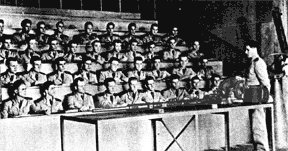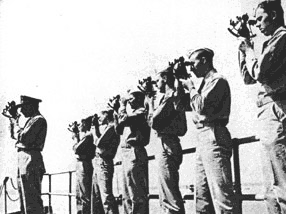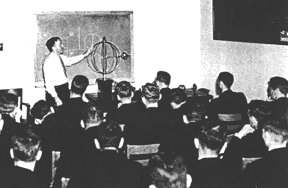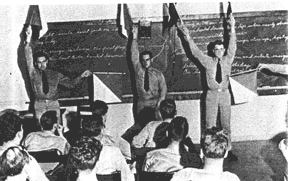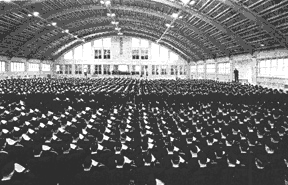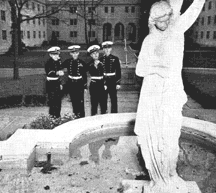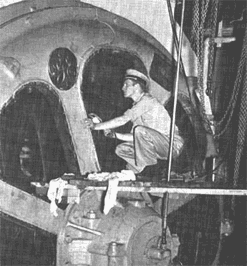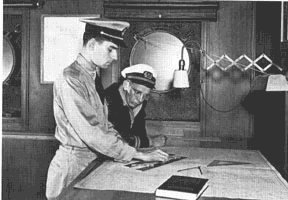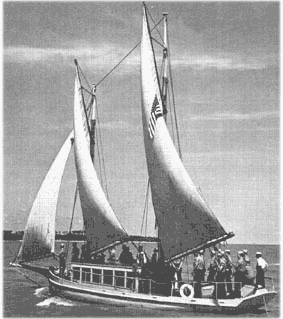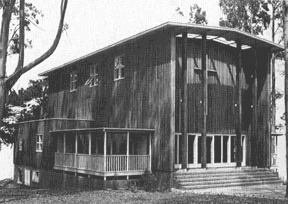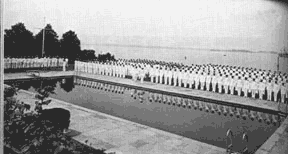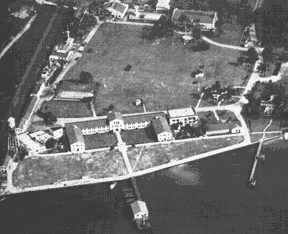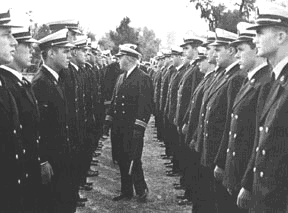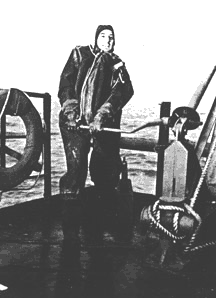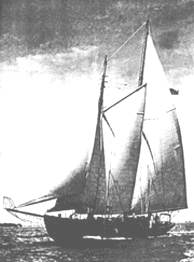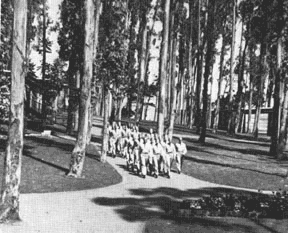History and Photos of Merchant Marine Cadet Corps Life in the 1940's
The Merchant Marine Act of 1936 directed that the merchant marine be "manned with a trained and efficient citizen personnel," but did not specify any structure for the Maritime Commission to follow. The Bland amendment of June 1938, created the United States Maritime Service for "training of licensed and unlicensed merchant marine personnel." The Maritime Commission's first report to Congress in January 1939 recommended establishment of a federal cadet system, and pointed out the need for officers with gunnery skills in case of war. In July 1942 control over the Cadet Corps was transferred from the Coast Guard to the War Shipping Administration.
Richard McNulty, who for years had preached the need for a formal training organization, became the first Supervisor of Cadet Training, a position he held for 12 years. McNulty and a staff of four worked out a curriculum and in September 1939 appointed 3 "Port Inspector-Instructors" in New York, San Francisco, and New Orleans for 325 cadets.
The Maritime Commission made selection to the Cadet program based on a National Competitive Examination, the first held on April 17, 1939. Of the 450 applicants, 166 passed the exam. Cadets were assigned to ships, whose Masters were responsible for supervising their work. Ashore, Port Inspector-Instructors supervised the training program which included an exam at the end of each sea year.
Pacific Coast Cadet Corps
The Port Inspector-Instructor on the Pacific Coast set up a temporary training facility in October 1939 aboard the California Nautical School's training ship California State which was docked in Tiburon. The next locations were the sternwheelers Delta King, Delta Queen, and Hunter Liggett Barracks on Treasure Island.In January 1942, the Maritime Commission purchased 10 acres on Coyote Point, San Francisco Bay, hastily built 11 buildings among the eucalyptus trees, and formally dedicated the facility on August 29th, 1942. In November 1944, 528 Cadet-Midshipmen were enrolled at San Mateo.
San Mateo's training ships were: Santa Rosa (renamed Thomas H. Sumner), and a submarine chaser renamed Ensign Herstam.
Gulf Coast Cadet Corps
The Gulf Coast Cadet Corps found its first home in June 1940 at the Coast Guard Air Station in Biloxi, Mississippi. By winter they moved to the commandant's old house at the Algiers Navy Yard. Evicted again, the District Cadet Training Instructor bought the North Star, a 120-foot houseboat, and leased land along Bayou St. John. Old Civilian Conservation Corps buildings were reassembled on the site.During a cruise, the North Star took shelter from a storm at the Inn-by-the-Sea resort in Pass Christian. An officer learned the hotel owners were willing to sell to the government and the deal was approved on August 29, 1942. The North Star was used to move the cadets to their new home in mid-September 1942. The training vessels at Pass Christian were: North Star (renamed Robert Waterman), Oneida, Alfred Haag (renamed John Land), Samuel Samuels (renamed Joshua Humphreys) and a submarine chaser renamed Ensign Strom.
Atlantic Coast Cadet Corps
The Atlantic Coast Cadet Corps first home, the schoolship Empire State, was shared with the New York Merchant Marine Academy at Fort Schuyler, New York beginning in October 1939. After a short stay at Admiral Billard Academy in New London, Connecticut, the Cadet Corps returned to Fort Schuyler.On December 8, 1941, the Maritime Commission agreed to purchase the 12 acre estate of Walter Chrysler at Kings Point, Long Island for $100,000. The estate was leased so classes could begin immediately while awaiting Congressional approval. Purchase of nearby properties eventually increased acreage to 60. By the summer of 1942, enrollment increased tenfold over that of January. Construction started on permanent classrooms and dormitories nearly immediately.
Cadet-Midshipmen were scheduled for over 60 hours of classes each week, but made time for extra-curricular activities such as Drill, Team, Glee Club, Camera Club and its largest club -- the Tin Fish Club. With an initial membership of 142, this exclusive club was limited to Cadets who had been forced to abandon ship because of enemy action.
The training vessels at Kings Point were: Nenemoosha (renamed William Webb), Sealove (renamed Robert Forbes), Rhine (renamed Felix Riesenberg), and Emory Rice.
In the Naval Science Building, San Mateo cadets learn the use
of a 20-mm Oerlikon anti-aircraft gun from a U.S. Navy lieutenant.
"Shooting the sun" is done outside, the problem being worked
out afterward in the classroom.
Experts, such as Mr. Brierly of the Sperry Gyro School,
are invited to King's Point Academy to explain their specialty.
Signal flags have never been superseded by radio for communication
between near-by ships.
USMM Cadet-Midshipmen in the great gymnasium during
ceremonies at the Kings Point Academy.
Future officers make pilgrimages to the shrine of
Amphitrite, goddess spouse of King Neptune
before examinations and as they leave the base.
The tradition started in 1942 when the Academy opened.
[Photo from "The Lookout"]
Engine cadet inspecting an electric motor aboard a ship.
Deck cadet learns navigation under the watchful eye of the Chief Mate.
Pass Christian Cadet Corps School training vessel Joshua Humphreys.
San Mateo's Farrell Chapel was completed in 1946.
Inspection at Kings Point.
Aerial view of Pass Christian Cadet Corps School.
Inspection at Pass Christian Cadet Corps School by U.S. Navy officer.
On his sea duty, a cadet dons his Morner lifesaving
suit during an abandon ship drill.
The training vessel Felix Reisenberg on Long Island Sound.
Marching at San Mateo Cadet School.
Sources:
Heaving Line, Sheepshead Bay, Dec. 30, 1944
He's In the Merchant Marine Now, John Scott Douglas and Albert Salz, New York: Robert M. McBride and Co.,1943
The United States Merchant Marine At War, Report of the War Shipping Administrator to the President, Washington DC, U.S. Government Printing Office, January 15, 1946
We'll Deliver: Early History of the United States Merchant Marine Academy, 1938-1956, C. Bradford Mitchell, Kings Point, New York: U.S. Merchant Marine Academy Alumni Association, 1977
U.S. Merchant Marine Cadet Corps History6/5/00
www.USMM.org ©1998, 1999, 2000. You may quote material on this web page as long as you cite American Merchant Marine at War, www.usmm.org, as the source. You may not use more than a few lines without permission. If you see substantial portions of this page on the Internet or in published material please notify usmm.org @ comcast.net
